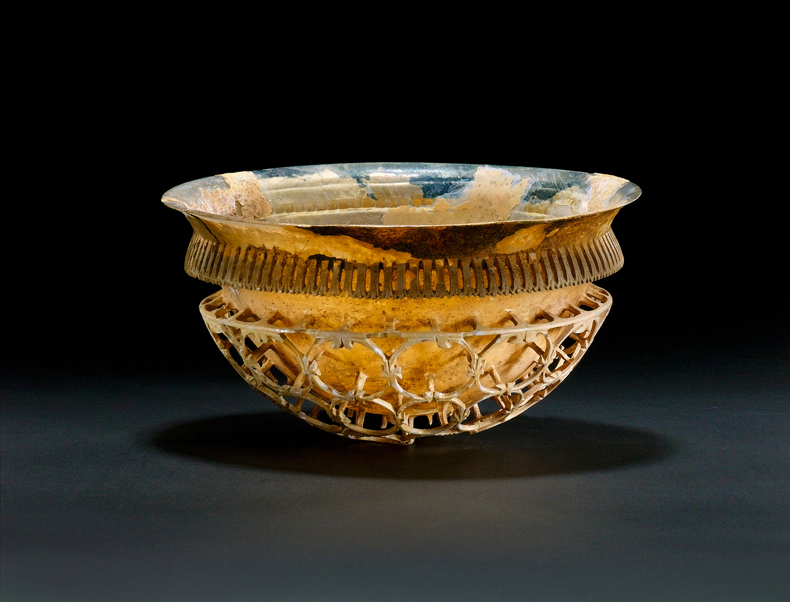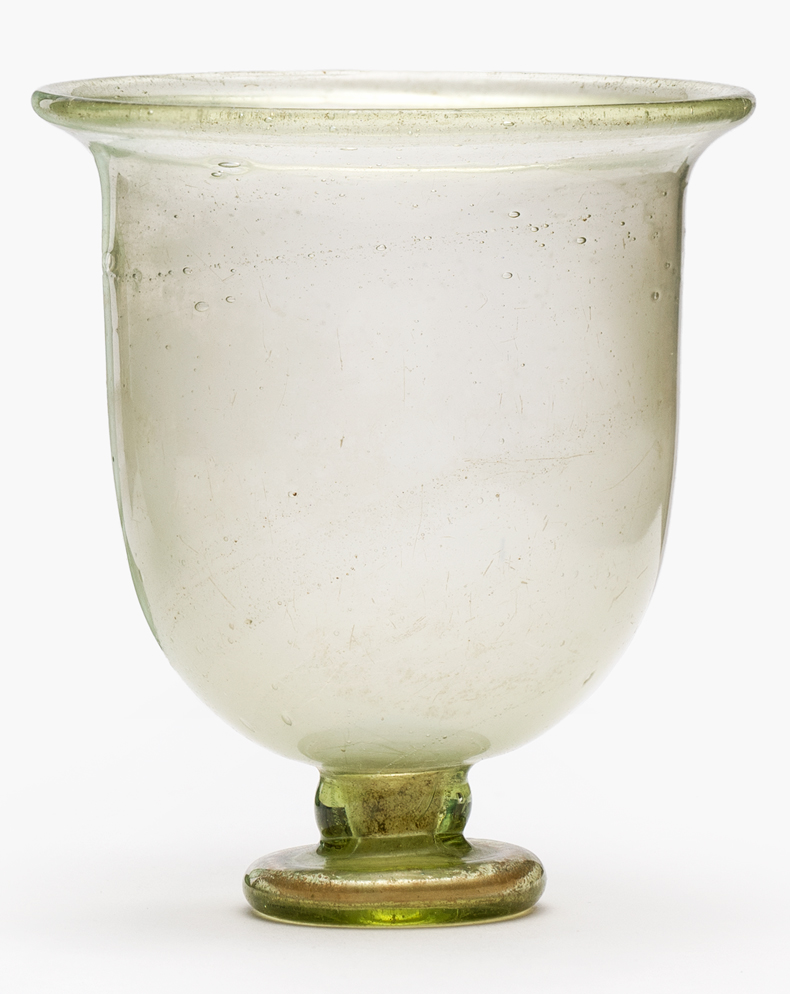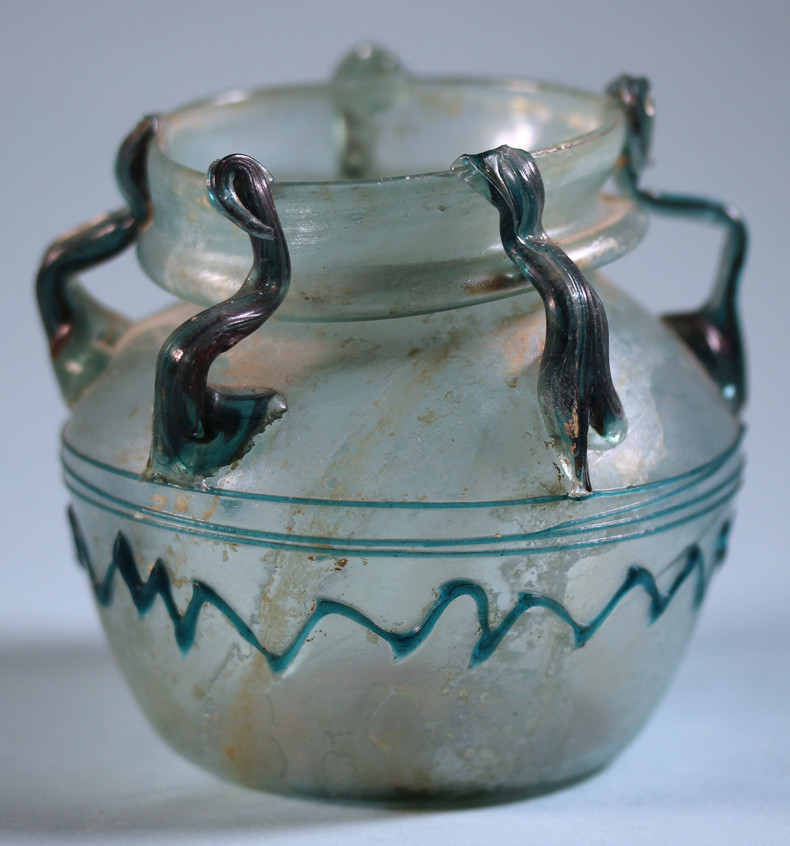From the December 2025 issue of Apollo. Preview and subscribe here.
On 26 June, London-based Charles Ede gallery mounted a spectacular exhibition as part of the one-day pop-up art fair Studiolo, held in St James’s grand Spencer House. In a version of the show that opened a month earlier in the gallery’s space in Mayfair, this was a collaboration with florist Shane Connolly, who, along with directors Charis Tyndall and Martin Clist, arranged on a high plinth a multi-coloured array of Roman glass, with many vessels holding elegant floral sprays. The gallery then repeated the stunt at Frieze Masters. By November, only 30 of 180 pieces, priced between £500 and £18,000, remained unsold.
Glass as a material dates back to at least the second millennium BC in Mesopotamia and Egypt. Glass beads were widespread and core-formed glass vessels were luxury items, the shapes created by heating ropes of glass over a sand and clay form, with sometimes elaborate contrastingly coloured decorative threads smoothed into the hot surface, and handles and feet added. In the first millennium BC, the Greeks and Phoenicians developed glass technologies further, including ‘slumping’ viscous glass over a mould and cutting bunched canes of glass cross-ways to produce mosaic-like millefiori decoration. All these techniques the Romans inherited from the eastern Mediterranean in the early days of the Republic. They added an interest in refining new types of monochrome and colourless tablewares. Other specialisms include the extremely rare and sought-after ‘cage-cups’ or diatreta, dated to the fourth century AD – tours de force of technique, consisting of an inner beaker and an outer decorative cage held by short stems. One of the few in private hands, the Constable-Maxwell cage-cup, achieved the auction record for a piece of ancient glass at Bonhams in London in 2004 when it fetched £2.6m against an estimate of £2m – it had twice before broken the record, in 1979 and 1986. This ‘cup’, once used as a lamp, was carved from a solid piece of glass in the third century AD.

What marked the Roman era, however, was the discovery of glass-blowing around the first century BC, near the Phoenician city of Sidon in what is now Syria. Symmetrical, light vessels in many colours could be created at speed and at scale, and the technology spread throughout the Roman Empire. The majority of pieces were feather-light vessels, used for oils, perfumes, ointments and other liquids. The prevailing colour is a ‘natural’ pale green-blue, depending upon the sand used to make the glass. Adding manganese oxide to the sand turns the glass a purple-aubergine colour; lead makes it yellow; cobalt oxide deep blue; while antimony oxide makes it colourless. Eye-catching vessels were traded throughout Europe and eastwards – Roman glass has been found in tombs in China.
These vessels were usually less expensive than their contents. But those that have survived have found a new value, especially where the soil has reacted with the surface of the glass to create a particular form of patina known as iridescence. Tyndall says: ‘People love the iridescent pieces. Each one is unique. But there are people who prefer the squeaky-clean glass pieces, which look as pure as they would have to the Romans.’ While trading in Roman glass must comply with the 1972 UNESCO World Heritage Convention, as a category it occupies an anomalous position: it is not uncommon, so the value of an individual piece tends to be comparatively small – not worth the effort of rescuing and forging false paperwork for export; at the same time, provenance is hard to establish. Tyndall explains that at Charles Ede they use comparative examples in museum collections to offer provenances, but most collectors are not preoccupied with the exact origins of the pieces. She suggests that there are plenty of fakes around but that any reputable dealer can tell the difference, and it is almost impossible to replicate iridescence.

There was always a small specialist market, Tyndall says. ‘Then after 2010 the market dipped dramatically. Fewer pieces came on the market as people became more concerned about provenance.’ She began acquiring in 2020: ‘I bought one piece for £1,000 that had been acquired from Sotheby’s in 1999 for £10,000 […] People don’t want 100 or 200 pieces any more. We used to sell a lot of pieces to a few people. Now we sell a few to a lot.’ Collectors today are looking for ‘rarity of form and colour, and the aesthetic quality of the piece.’ According to Joanna van der Lande, senior consultant in antiquities at Bonhams, ‘We are seeing a new generation of collectors emerging who are drawn to collecting these beautiful and fragile antiquities, while glass from [important] earlier collections has a particular premium.’ This month, Bonhams will offer the exceptional Schefler Collection, begun in the late 1960s, in the Antiquities live sale (4 December), as well as the Classics Online sale (until 10 December). The collection includes a Roman fused mosaic and blown amphora of green with red, yellow and white glass from the early 1st century AD (estimate £6,000-8,000).
The Amsterdam-based dealer Mieke Zilverberg confirms a marginal recovery in the market: ‘In the 1980s and 1990s there was a lot of interest in Roman glass. Then it fell away.’ However, ‘For the last 10 years it has climbed back up, although the implementation of the post-Brexit trade rules has dimmed interest from the UK.’ It is hard to source the very rare pieces at fairs today. Mould-blown janiform sprinklers, with their double heads, are the most attractive to collectors: ‘They may be from the third century but they look edgy today.’

The master of mould-blown glass, Ennion, worked in the first half of the first century AD, and today signed pieces by him are highly sought-after. The Metropolitan Museum of Art and the Corning Museum of Glass held a joint exhibition of his work in 2014–15. At Christie’s London in 2016 a first-century AD Roman pale purple glass Ajax amphoriskos – mould-blown, the oval body decorated with two scenes from the mythological cycle of Ajax, with iridescence – sold for £74,500. Although this was unsigned, it had been included in an exhibition at the Israel Museum in Jerusalem as part of ‘Made by Ennion: Ancient Glass Treasures from the Shlomo Moussaieff Collection’, illustrating the power of association as well as the effect on value of a noted provenance.
Randall Hixenbaugh set up his antiquities gallery in New York 20 years ago. Roman glass was an attractive part of the inventory from the start: ‘I have been able to purchase large collections in New York – many people brought Roman glass back from Israel.’ Hixenbaugh agrees with Tyndall that today’s collectors buy far fewer pieces, focusing on the most interesting: ‘What was valuable in antiquity is what is valuable today: varying colour, marbling, intricate handles, forms that would have been impressive at the time.’ This means, as Hannah Solomon, head of Christie’s antiquities department in New York suggests, that while ‘prices have come down significantly, as seen with the sale of some of these encyclopaedic collections, including that of John F. Fort (2016) and Estate of Jack and Jane Weprin (2022/23), there is still appreciation for more technically sophisticated styles and manufacturing.’ She cites a roman mould-blown cobalt blue glass globular bowl with inscription (circa 1st century BC), which sold for $94,500, more than six times the upper estimate, from the Weprin sale in New York in 2022, as well as an elegant Roman gold-band glass mosaic bottle (early 1st century BC), which sold in London the same year for £81,900, against a £15,000-£25,000 estimate.

London-based antiquities dealer Rupert Wace notes that there are collectors, too, of fragments of the extremely rare cameo-etched glass vessels, in which two layers of glass are blown together and then carved by specialist gem and glass engravers. The British Museum’s Portland Vase, dated 5–25 AD, is the most famous surviving example. Wace, who has available a cameo glass fragment of a satyr from the early 20th-century Giorgio Sangiorgi collection, adds: ‘Prices for the most exceptional pieces have certainly risen and combined with rarity, skill of manufacture and a famous old collection history, then these pieces are in strong demand.’
From the December 2025 issue of Apollo. Preview and subscribe here.
